We’ve been told to stand up straight so many times that introducing the idea that it might be compromising our health seems absurd. If you have some degree of hyperkyphosis (extra rounding forward in your upper back) the solution is not as simple as rolling your shoulders back, squeezing your shoulder blades together, or increasing your time spent in “heart-opening” yoga backbends. These postural cues have the tendency to give you the appearance of being straighter without actually doing very much to decrease the extra rounding in your spine (kyphosis) and while also taking more of your parts out of alignment (for example, taking your ribs forward of your pelvis), compromising your core strength and impeding your shoulder mobility.
Let’s use some objective markers to evaluate your hyperkyphosis.
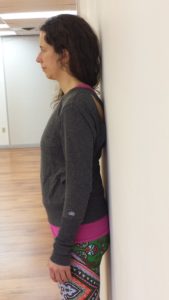
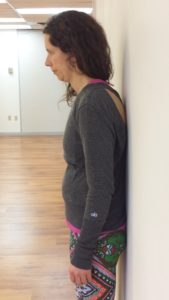 Start by standing with your heels a few inches away from the wall. Standing tall, bring the back of your head towards the wall. Observe how much of your back body is not on the wall between your shoulders and your butt. (photo on left)
Start by standing with your heels a few inches away from the wall. Standing tall, bring the back of your head towards the wall. Observe how much of your back body is not on the wall between your shoulders and your butt. (photo on left)
Now exhale and relax your head, neck and shoulders. Allow your head to come off the wall and your upper body and shoulders to round forward in order to get your back ribs to the wall, all the way to your bottom ribs. (photo on right)
This may be very challenging if you haven’t released your psoas muscles first (that’s for another blog). Do your best and see if you can get those ribs back to where they belong (stacked over your pelvis not way out in front of you). Notice how much your head and upper body need to come forward away from the wall for this to happen. This is the current state of your hyperkyphosis, the amount of extra forward curve that exists in your upper spine. When you think you are standing up straight or when you practice a backbend in yoga you are not making this extra kyphosis go away, you are simply masking it with a forward thrust of the ribcage. To truly address the extra kyphosis you need to both be able to relax (not force) your ribs down AND be able to activate your spinal extensor muscles. This involves more than just creating the appearance of a particular shape.
When I discovered this in my body after more than a decade of committed yoga asana practice, I cried. I felt let down by my yoga practice. Like it had been lying to me. So if you’re feeling a little down about this right now, I get it. Most of us these days have some hyperkyphosis. The good news is you have some new awareness and that is the first step towards doing something about it!
Maybe you’re not buying this. You are not sure the suggested objective marker of ribs over pelvis is relevant. Let’s try two other tests: one for core strength and one for shoulder mobility.

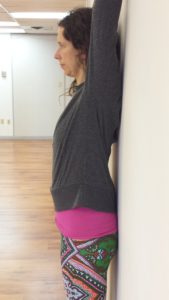
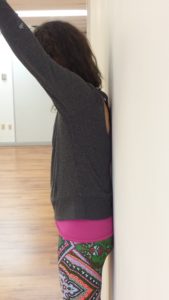
Go back to your initial standing position and then raise your arms overhead until your hands touch the wall behind you. Notice the parts of your back body not on the wall between your shoulders and your butt.
Now do it again, this time with the ribs to the wall position. Were you still able to get your arms to the wall? Make sure your back ribs are completely on the wall. Reach a hand behind to make sure there is no space except at your low back. So now you can see that the position of your ribs affects your shoulder mobility. Anytime you are trying to stretch your shoulders you’ll need to mind your ribs.
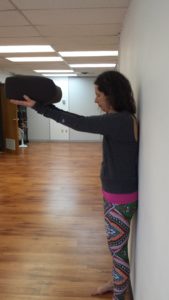
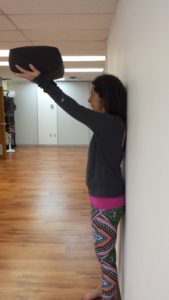 Ok, this time go back to your initial starting position and take a bolster or pillow and raise it up like I’m doing in the photo. Don’t worry about your rib position and notice if you feel your abdominals activate as you do this.
Ok, this time go back to your initial starting position and take a bolster or pillow and raise it up like I’m doing in the photo. Don’t worry about your rib position and notice if you feel your abdominals activate as you do this.
Now do it again, this time with the ribs to the wall position. Notice a difference in your core activation?
So you can see that the position of your ribs affects your ability of your core to turn on. If you’re dealing with a diastasis recti (unnatural distance between the two sides of the rectus abdominal muscles) or a prolapsing organ this is important!
So what do you do to fix all of this? You’re already part way there. You’ve brought more awareness to how you are carrying your ribs. Start by checking in with your rib position regularly. Notice when you’re letting them get out in front of you and try to relax them down and back where they belong. If this is difficult and feels like you need to use force to bring your ribs down you may need to work on releasing your psoas muscles first. Stay tuned for another blog post on the psoas!
If you’re motivated to learn more, I will be offering a workshop on releasing the psoas and another one on exercises to help with hyperkyphosis in the coming months. I also address the psoas, shoulders and core in most of my class series. Subscribe to my newsletter below to stay informed!


